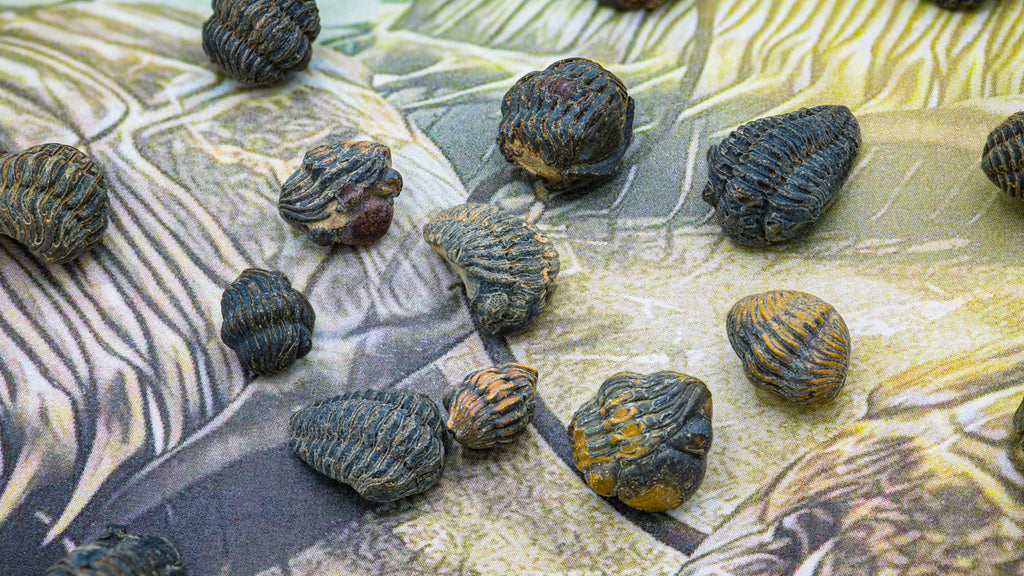Trilobite Display Case & Handheld Sizes










Trilobite Display Case & Handheld Sizes









































Above: Front of Specimen Card
No creature exemplified the diverse nature of life more than the trilobite. This class of arthropods formed a staggering amount of different species throughout the Cambrian period. Today, over 5,000 different genera of trilobites have been discovered and named, with more surely waiting to be discovered.

Above: Large Handheld Specimens
This specimen is a trilobite from Morocco. They come from Silurian and Devonian formations and date to 350,000,000-400,000,000 years old.

Above: A Riker Box Trilobite Specimen
Trilobite Sizes:
- Small Riker Box - Roughly 5mm to 1cm in length, each trilobite is secured in acrylic specimen jars and housed inside our classic, glass-topped riker display cases. The cases measure 4 1/2" x 3 1/2". Genus is broadly categorized under Phacops africanus. A small information card is also enclosed that also serves as the certificate of authenticity.
- Large Handheld Specimens - 2" and up, these larger specimens are too big for a riker box and will ship in our sturdy cartons. Genus is typically Flexicalymene though broadly categorized under Phacops africanus. A small information card is also enclosed that also serves as the certificate of authenticity. And yes, you will want to hold them. That's a-ok!
Please Note: Each trilobite is a unique individual. Positioning and coloring will vary widely. Some are flat and some are curled in a ball-like position. This is completely normal. As pictured, large trilobites may show some signs of repair.

Above: Large Handheld Specimens
More About Trilobites
"We are beginning to understand how a group of animals sometimes regarded as ‘primitive’ were actually sophisticated and varied. Had it not been for the Permian extinction event they might be with us still." ~ Richard Fortey, paleontologist at the Natural History Museum in London.

Above: Small Riker Box Trilobite Specimens
It is through diversification and evolution that life is able to succeed. No creature exemplified this principle more than the trilobite. This class of arthropods formed a staggering amount of different species throughout the Cambrian period. While all species shared some common aspects, each would evolve unique adaptations that set them apart. Today, over 5000 different genera of trilobites have been discovered and named, with more surely waiting to be discovered.
The common structure that all trilobites share is rather simple. They had a hard exoskeleton composed of three lobes: left, right, and center. Their bodies are also segmented into a cephalon (head), thorax (body), and pygidium (tail). From this base, trilobites evolved into a myriad of strange and unique forms. Some specimens have even been discovered with fossilized soft tissues such as legs, gills, and antennae, giving us a clearer picture of the trilobite’s form in life.

Above: Large Handheld Trilobite... in hand!
Spiny exteriors were a common adaptation and were used by some species to ward off predators while others developed spines as a hunting tool. Compound eyes were found in many species, with some having enormous oculars giving them nearly 360-degree vision. Specialized exoskeleton articulation even allowed them to roll into a ball. Trilobites varied in size as well, from a mere tenth of an inch long to the massive 28 inch Isotelus Rex.
Trilobites had an incredibly varied amount of lifestyles to match their many variations in form. Fossils have been discovered in areas that would have been shallow basins of saltwater as well as the floors of ancient trenches. Ocean floor scavengers, predators, filter feeders, swarming schools, and even open water swimmers have all been suggested modes of survival of different groups. There is even evidence some species made short trips onto dry land.
The trilobite’s appearance in the fossil record is somewhat mysterious. It is thought that they first appeared in what is now modern-day Siberia nearly 500 million years ago, though their origin before this is shrouded. Early trilobites diversified so quickly any common ancestor is unclear. Trilobites flourished throughout the Cambrian period and survived for hundreds of millions of years through several mass extinction events until the Permian extinction finally caused the last species to die out.
Today, trilobite fossils are found all over the world, marking the spaces that once held ancient marine life. Being widespread through the Cambrian period, they serve as excellent stratigraphic markers and help to date other rocks and specimens found near them. Their calcite exoskeletons fossilize wonderfully, though the soft tissues that made up their legs and organs are rarely found. Their eye structures however were also made up of calcite, allowing scientists to study the delicate compound lenses that allowed trilobites to see.
In these ancient and strange creatures, we can find the diverse history of evolution on planet Earth. Held within the trilobite is evidence of life’s tenacity to adapt to anything.

Further Reading:
Fortey, Richard A. “The Lifestyles of the Trilobites: These Denizens of the Paleozoic Era Seas Were Surprisingly Diverse.” American Scientist, vol. 92, no. 5, 2004, pp. 446–453.
Briggs, Derek E. G., et al. "Middle Cambrian Arthropods From Utah." Journal of Paleontology, vol. 82, no. 2, 2008, pp. 238-254.
Chatterton, Brian D. E., and Stacey Gibb. "Latest Early To Early Middle Devonian Trilobites From The Erbenochile Bed, Jbel Issoumour, Southeastern Morocco." Journal of Paleontology, vol. 84, no. 6, 2010, pp. 1188-1205.

Above: Back of the Specimen Card.
